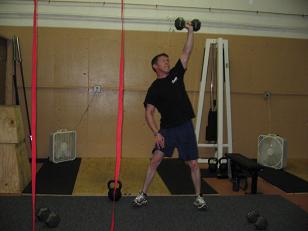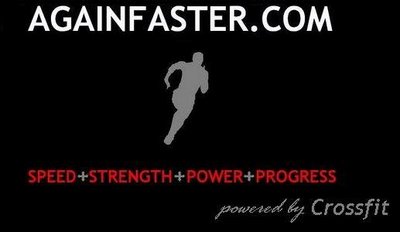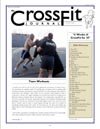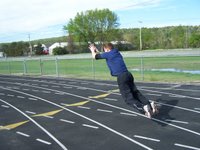Unilateral Support

When was the last time you picked something up with one hand? Probably about two minutes ago. We do it all the time, yet our training is typically done with both hands.
The last time you pressed, cleaned, snatched, or deadlifted, you did it bilaterally. You gripped an loaded barbell with both hands, and did the movement. This pattern is not innate.
We're not programmed to do things with both hands. You are right- or left-side dominant. You use your dominant arm/hand/leg/foot for writing, throwing, kicking, pulling, and pushing.
This predilection toward one side carries over into bilateral movements.
When you do these movements, your dominant side does more work than your non-dominant side. This happens because the human body craves efficiency. Why push harder with the left arm, if the right arm can get the job done?
This efficiency of movement is self-reinforcing. Your right arm does more work than your left, receiving more of the strength gains from training. Because it gets more relative benefit from training, it continues to dominate your left.
The fix is simple. Unilateral movements.
If you're a Crossfitter, you've had some exposure to the one-arm overhead squat, split jerk, walking lunge, and snatch. These exercises require you to move an unbalanced load through a significant range of motion. They only utilize one side of the body at a time, forcing that side of the body to do the vast majority of the work. This precludes any help from the other side, dominant or not.
The weapon of choice for these exercises is either a dumbbell or a kettlebell. The kettlebell will slightly increase your lever length (distance from your shoulder to the center of mass of the external object) in the pull portion of the snatch and the clean, requiring you to do relatively more work than a dumbbell.
This relationship is reversed in during the jerk portion of the C&J, the overhead squat, and the walking lunge, where the kettlebell handle decreases lever length by placing the center of mass closer to your shoulder.
You should work with both of the dumbbell and the kettlebell--constant variety ensures adaptation and keeps things from getting stale.
In practice, you should always perform unilateral movements with both sides of your body. Do your reps with the non-dominant side first, and move to the dominant side later.
Fatigue builds when you're doing any exercise. By using your non-dominant side first, you ensure that fatigue will not prevent you from completing your prescribed reps.
Use a challenging weight. After you've mastered the mechanics of the movement, make sure you're using enough resistance on the non-dominant side to develop strength and power. If you're doing 10 reps per side, use a weight that represents your 12-15 repetition maximum for your dominant side. This will keep the non-dominant side working hard.
Gear your unilateral training toward closing the load gap, so that your repetition maximum is equal for each side.
In addition to helping correct dominance-related imbalances, unilateral movements will help you develop balanced rotational strength.
Rotational strength is called into play whenever we throw, kick, swing, or twist in any way. Nearly every sport I can think of requires its athletes to exhibit power while rotating through the sagittal plane.
When you have a weight extended overhead, using only one arm, a significant amount of the load is borne by your core on the side away from the load. If your right arm is extended overhead, your left-side obliques bear more load than your right-side obliques.
Grab a dumbbell, and do a one-armed overhead squat. Press your "up" shoulder to your ear, look at the weight, and rotate inward slightly as you descend into the squat. Concentrate on your torso. Which side is contracted more?
By overloading the obliques/lats on one side or the other, we develop the ability to use those muscles more effectively for rotation and stabilization. This ability transfers directly to sport.
Just as you're side-dominant, you also have a predilection toward rotating either clockwise or counter-clockwise. Early commentators in snowboarding, skateboarding, and rollerblading dubbed these rotations "natural" and "unnatural".
Working on eliminating the general dominance of one side of your body aids the elimination of rotational dominance. Elite athletes can rotate in either direction with ease. This skill differentiates truly great competitors in baseball, football, soccer, board sports, and gymnastics. It is the foundation of agility.
Unilateral training has obvious merit. We incorporate it into our workouts all the time.
A few weeks ago, we did a WOD geared toward unilateral development at Crossfit Topsfield. It's a barnburner.

For time:
10 kettlebell swings
20 one-armed overhead squats (10 left, 10 right)
30 one-armed split jerks (15 left, 15 right)
40 one-armed walking lunges (20 left, 20 right)
30 one-armed split jerks (15 left, 15 right)
20 one-armed overhead squats (10 left, 10 right)
10 kettlebell swings
Remember to start with your non-dominant side first. If you need an explanation of any of these exercises, shoot me an email using the link in the right sidebar.
If you want to get crazy with it, try a one-armed snatch, squat, clean, or press with the AF bar. It requires tremendous stabilization. I did a one-armed snatch with it yesterday during "Again Faster in Chains", and it almost knocked me on my ass.
That would've been embarrassing.
Go faster!

When was the last time you picked something up with one hand? Probably about two minutes ago. We do it all the time, yet our training is typically done with both hands.
The last time you pressed, cleaned, snatched, or deadlifted, you did it bilaterally. You gripped an loaded barbell with both hands, and did the movement. This pattern is not innate.
We're not programmed to do things with both hands. You are right- or left-side dominant. You use your dominant arm/hand/leg/foot for writing, throwing, kicking, pulling, and pushing.
This predilection toward one side carries over into bilateral movements.
When you do these movements, your dominant side does more work than your non-dominant side. This happens because the human body craves efficiency. Why push harder with the left arm, if the right arm can get the job done?
This efficiency of movement is self-reinforcing. Your right arm does more work than your left, receiving more of the strength gains from training. Because it gets more relative benefit from training, it continues to dominate your left.
The fix is simple. Unilateral movements.
If you're a Crossfitter, you've had some exposure to the one-arm overhead squat, split jerk, walking lunge, and snatch. These exercises require you to move an unbalanced load through a significant range of motion. They only utilize one side of the body at a time, forcing that side of the body to do the vast majority of the work. This precludes any help from the other side, dominant or not.
The weapon of choice for these exercises is either a dumbbell or a kettlebell. The kettlebell will slightly increase your lever length (distance from your shoulder to the center of mass of the external object) in the pull portion of the snatch and the clean, requiring you to do relatively more work than a dumbbell.
This relationship is reversed in during the jerk portion of the C&J, the overhead squat, and the walking lunge, where the kettlebell handle decreases lever length by placing the center of mass closer to your shoulder.
You should work with both of the dumbbell and the kettlebell--constant variety ensures adaptation and keeps things from getting stale.
In practice, you should always perform unilateral movements with both sides of your body. Do your reps with the non-dominant side first, and move to the dominant side later.
Fatigue builds when you're doing any exercise. By using your non-dominant side first, you ensure that fatigue will not prevent you from completing your prescribed reps.
Use a challenging weight. After you've mastered the mechanics of the movement, make sure you're using enough resistance on the non-dominant side to develop strength and power. If you're doing 10 reps per side, use a weight that represents your 12-15 repetition maximum for your dominant side. This will keep the non-dominant side working hard.
Gear your unilateral training toward closing the load gap, so that your repetition maximum is equal for each side.
In addition to helping correct dominance-related imbalances, unilateral movements will help you develop balanced rotational strength.
Rotational strength is called into play whenever we throw, kick, swing, or twist in any way. Nearly every sport I can think of requires its athletes to exhibit power while rotating through the sagittal plane.
When you have a weight extended overhead, using only one arm, a significant amount of the load is borne by your core on the side away from the load. If your right arm is extended overhead, your left-side obliques bear more load than your right-side obliques.
Grab a dumbbell, and do a one-armed overhead squat. Press your "up" shoulder to your ear, look at the weight, and rotate inward slightly as you descend into the squat. Concentrate on your torso. Which side is contracted more?
By overloading the obliques/lats on one side or the other, we develop the ability to use those muscles more effectively for rotation and stabilization. This ability transfers directly to sport.
Just as you're side-dominant, you also have a predilection toward rotating either clockwise or counter-clockwise. Early commentators in snowboarding, skateboarding, and rollerblading dubbed these rotations "natural" and "unnatural".
Working on eliminating the general dominance of one side of your body aids the elimination of rotational dominance. Elite athletes can rotate in either direction with ease. This skill differentiates truly great competitors in baseball, football, soccer, board sports, and gymnastics. It is the foundation of agility.
Unilateral training has obvious merit. We incorporate it into our workouts all the time.
A few weeks ago, we did a WOD geared toward unilateral development at Crossfit Topsfield. It's a barnburner.

For time:
10 kettlebell swings
20 one-armed overhead squats (10 left, 10 right)
30 one-armed split jerks (15 left, 15 right)
40 one-armed walking lunges (20 left, 20 right)
30 one-armed split jerks (15 left, 15 right)
20 one-armed overhead squats (10 left, 10 right)
10 kettlebell swings
Remember to start with your non-dominant side first. If you need an explanation of any of these exercises, shoot me an email using the link in the right sidebar.
If you want to get crazy with it, try a one-armed snatch, squat, clean, or press with the AF bar. It requires tremendous stabilization. I did a one-armed snatch with it yesterday during "Again Faster in Chains", and it almost knocked me on my ass.
That would've been embarrassing.
Go faster!




















0 Comments:
Post a Comment
<< Home